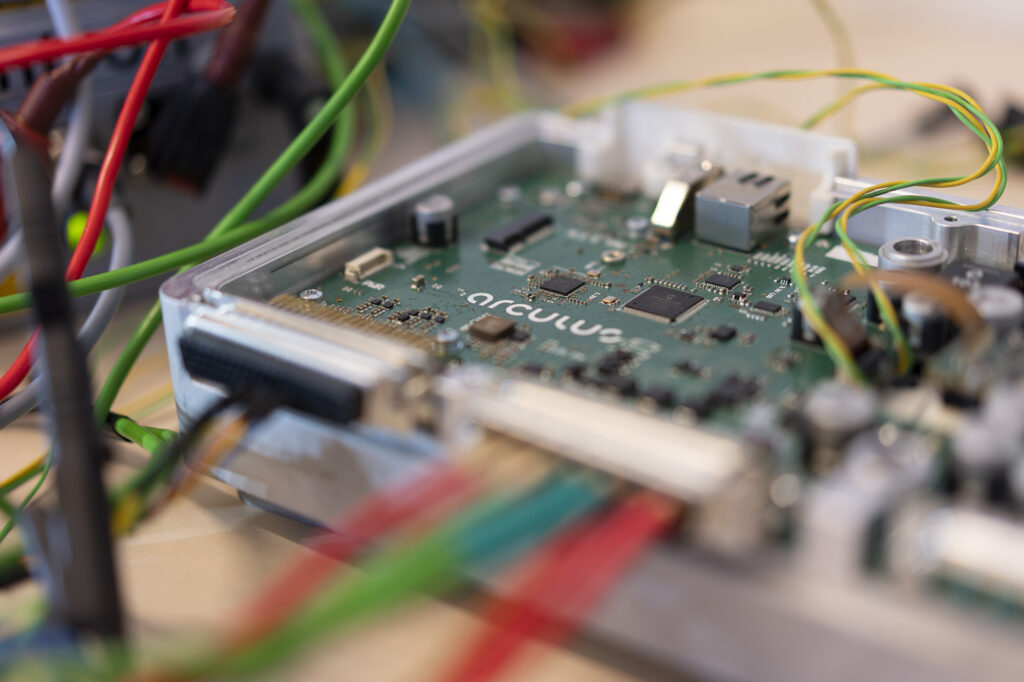At the core of every robot are electronics components that drive its functionality. In the case of the arculee, the most significant of these elements is the RCU® – one central Robot Control Unit. This blog post delves into the electronic heart of our robot, providing insights from engineer Tobias Schwering. We’ll uncover the RCU®’s integral role in coordinating and enhancing the robot’s performance, while discussing the challenges involved in its in-house development and production.
A first look inside the RCU®
The RCU®, short for Robot Control Unit, is the central electronic control module of our Autonomous Mobile Robot (AMR), the arculee. It integrates most of the robot’s functions onto a single self-developed Printed Circuit Board (PCB). arculus’ Senior Electronics Developer, Tobias Schwering, explains that this unit can roughly be divided into five parts:
- Power distribution system: connects two 48V batteries to power consumers (such as motors and lifts), generates different voltages (e.g., 24V, 12V, 5V) for various functions, and manages the robot’s on and off procedures;
- Central Computing System: runs the robot’s higher-level software (or “brain”) on an embedded Linux module (Nvidia TX2) and provides communication interfaces such as Ethernet and USB ports, as well as a certified WiFi bridge and a 5G mobile modem for connecting to the customer’s network;
- Three Inverter Modules: self-designed inverters capable of delivering 70A of current, enabling the arculee to perform heavy lifting tasks.

Taking it to heart
In many ways, the RCU® serves as a central hub for the arculee, almost as a “heart”. Firstly, it is the core power distributor within the robot, supplying electricity to all its subsystems. Additionally, it serves as a communication hub, collecting sensor information and processing it within the embedded Linux module. This data is then transmitted to the fleet management software, enabling the generation of precise instructions for the robots.
Keeping it in the family
As with most of the arculee’s inner parts, the RCU® was entirely developed and designed in-house. But Tobias explains that this wasn’t the original idea: “We were planning to have an external company working on it. But we soon realised that the complexity of the system was too high. It was also too entwined with the rest of the robot for such a combination to work properly. So, we brought the design in-house and have never regretted it.”

Full control over the RCU®’s design allows the team to directly tailor the arculee’s electronics to different customer needs and easily implement new functionalities. The tailored inverter hardware and software design also vastly improved the performance of the robot’s driving system, as it allowed for increased power.
“To develop the RCU® internally, we need a deep understanding of all its subsystems, which enables us to fully optimise all of them to our use cases. And the learning never stops, so each version of the RCU® has substantial improvements over the last one and enables additional use cases.”
Tobias Schwering, Senior Electronics Developer
The RCU® development process
Developing exceptional robots requires continuous refinement. With the RCU®, it’s no different. “Many times we realised that the assumptions we made in advance and that drove the design, didn’t fully meet reality. And new requirements appeared during the development process. So, we constantly needed to adapt and adjust the design accordingly.”, explains Tobias.
In other words, with each iteration cycle, the team draws from accumulated knowledge to make necessary adjustments. This involves streamlining the design by removing unused interfaces and systems, creating room for innovative functionalities that enhance the RCU. Along these lines, established performance metrics were also constantly reassessed and refined, ensuring that tasks were clear and well prioritised within the roadmap. Furthermore, to enable retrofitting, the team aims for backwards compatibility of the RCU® where feasible.

One of many challenges
The continuous iteration approach allowed the team to overcome a number of obstacles that appeared during the development of the RCU®. For Tobias, “One of the greatest challenges was integrating both power electronics that favour wide and thick copper structures on the PCB and high-density logic systems with high-speed communication – that favour the exact opposite – on the same PCB.”
While having both on the circuit board is possible, it requires special fabrication technology. And that’s what the team tried to avoid, as it would lead to greater complexity, longer lead times, and higher costs. The final solution for the issue involved a mix of creativity, electronics, and craftsmanship, and you can read the full story told by Tobias himself here.
What’s next for the RCU®?
As previously mentioned, robotics developments at arculus are characterised by constant iterations. Therefore, as the RCU® has reached a consistent state, its future developments are constant updates and modernisations. According to Tobias, the next big step planned is updating the Linux module. “As it’s so deeply integrated into our system, we shied away from updating it for a long time. But we have now enhanced most parts of our robot. Thus, we are now at a point where we can really profit from an improved central computing system”, he explains.

The plan is to switch to an enhanced SOC (system on chip) of the latest generation on Nvidia’s Linux modules. And that promises a significant increase in performance and efficiency. “At the same time, we will also integrate a bunch of other smaller improvements”, says Tobias. But readers will have to remain curious about these for now.
The true impact of it all (TL;DR)
In conclusion, the RCU® serves as the beating heart of the arculee, centralising power distribution and orchestrating seamless communication among various subsystems. Its in-house development empowers arculus to tailor this control unit precisely to meet different customer needs, resulting in enhanced robot performance and adaptability.
The continuous iteration approach to development, demonstrates arculus’ commitment to innovation. With the RCU® at the core, we continue our journey towards pushing the boundaries of robotics, aiming to integrate the latest generation of Linux modules to further elevate the arculee’s capabilities. As the heartbeat of arculus’ robotics solutions, the RCU® paves the way for a future of excellence and advancements in autonomous mobile robotics.
“Learning is the key to good engineering. Everyone makes mistakes while designing today’s complex systems, as many challenges are not obvious until someone has faced them. But it is important to grow with these and do it better next time.”
Tobias Schwering, Senior Electronics Developer